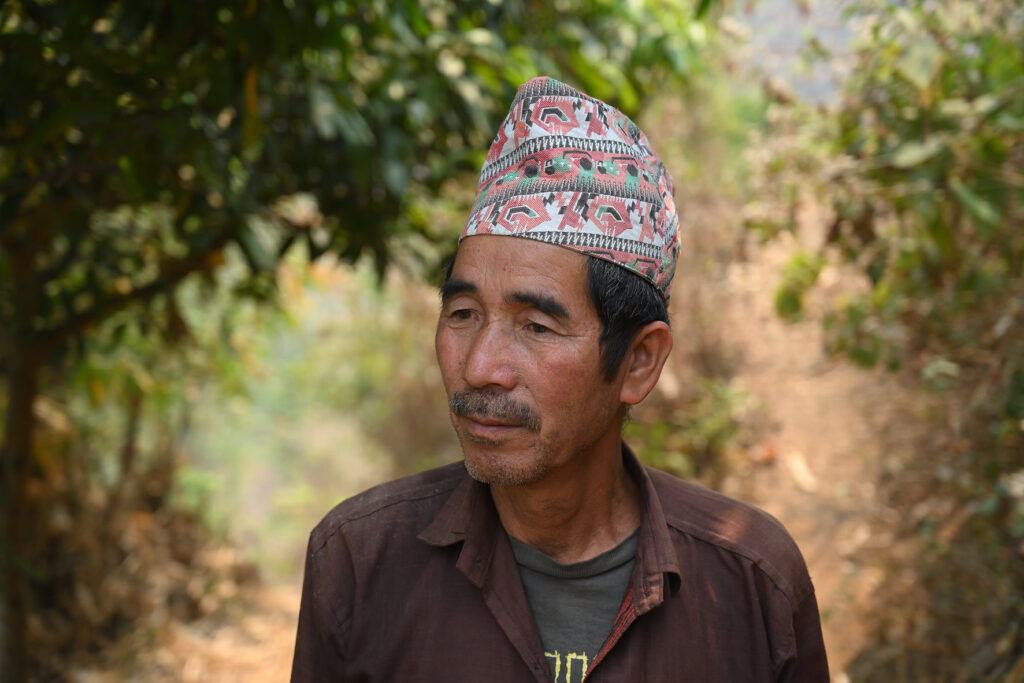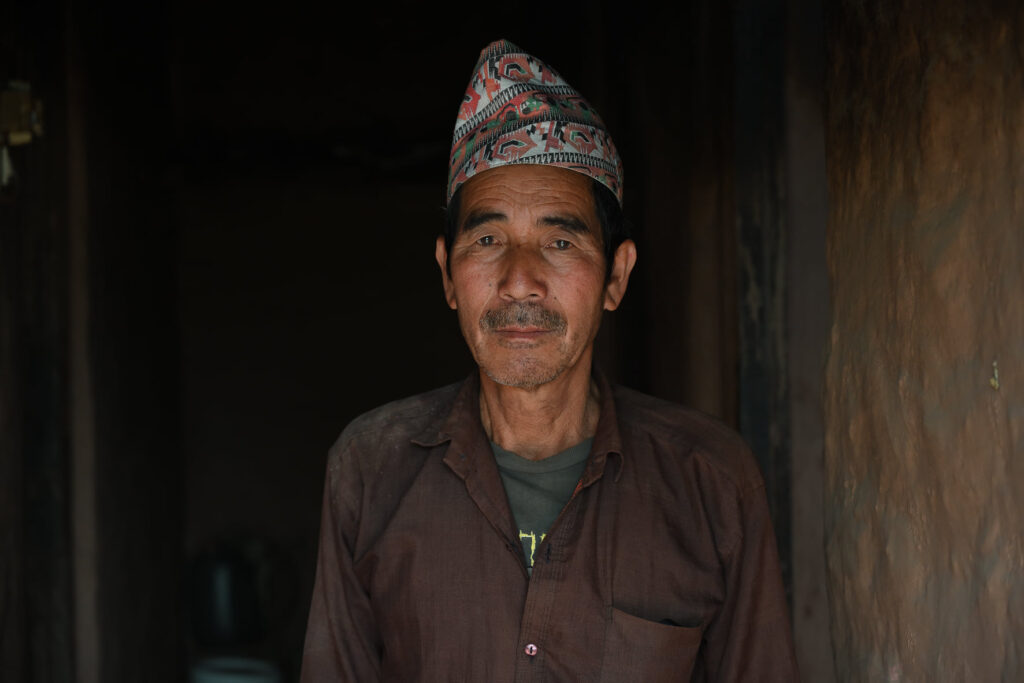
Pratiman Gharti Magar Alitaal 8, Kurjeni, Dadeldhura
“My grandmother was a visionary woman. She would tell me about the importance of water. I wonder who gave her the awareness. She did not go to school. She did not read about the conservation of nature. However, she knew. She knew what living with nature meant. Trees, rivers, hills and mountains were revered during those times. Development never meant cutting down forests and polluting the water. Somehow, her words became ingrained in my mind. As I grew up new roads started to be built in and around these hills. More people came, markets started to become denser and the population increased. There would be 100 trees and one man. Now, there are 100 men and one tree. They deforested if you see. All of the trees, all of the shrubs and all of the jungle. The whole Chure region became deserted. Water became scarce. The water source dried up. I witness this and it hurt me. It would take me back to my grandmother who spoke of the importance of water. I needed to do something about it. I knew that I could not do this on my own. How can one man preserve a natural water system? All the members of the community needed to come together. I joined a conservation group formed by Rural Development Center (RDC) supported by Paani Program that was involved in mapping out and searching water sources and studying why they dried up. This has something I had always wanted to do. Every day, I would go out with a few of my colleagues and search for water sources. In those years, I realized that the rampant deforestation around the water source was the primary reason for the depletion of water. In addition, the number of people and settlements had increased which was not proportionate with the natural resources available in the area. I remember, in Dolakot, buffaloes would bathe in those ponds, which were naturally recharging rainwater to the ground for ages. Due to such practices, we had enough water in our springs but now it was all gone. When I witness these water sources drying up one after the other, it scared me. I knew that if it continued one day we would all die of thirst. With the support from Paani Project, we started to work to restore water sources. There were several discussions, training, surveys and ideas both from experts and communities leaders. We started planting trees and shrubs around the water sources. We gathered communities and shared our understanding of how deforestation and open grazing around the water sources contributed to the depletion of water. We built water eyebrows trench and recharge ponds and pits where rainwater would accumulate and help keep the ground moist. We fenced areas to block rain debris from flowing down the hill and blocking the water source. Eventually, we started seeing changes in the water source. When the villagers started seeing how the spring sources restored, they finally conclude that what we had advocated was true and that preserving was possible. It could be done in a natural and organic way. This recharged everyone’s perception of conservation. Some even contributed their land to the protected area around the water source. Today, we have enough drinking water and enough water for the animals. And it was only possible through community agreement and collective effort. For me, I thank my grandmother for instilling the values in me through which I could mobilize my family and neighbours to support my passion. Moreover, thanks to the Paani project for delivering technical knowledge for protecting our valuable spring sheds that emphasized continuation of our own indigenous practice. If she were alive today, I would take her to these water sources and show her with pride what we have achieved.”
(Pratiman Gharti Magar, Alitaal 8, Kurjeni, Dadeldhura)



(Pratiman Gharti Magar is a secretary of Sim Khola Resource Conservation Group formed with support from the USAID’s Paani – पानी Program. He led source protection work at spring shed in Aalitaal -3 to solve water scarcity in the Dolakot hillside. Now they have managed to restore sufficient water for the village) #riverstories with Paani
– पानी“मेरी बजै निकै दुरदर्शी हुनुहुन्थ्यो । पानीको महत्व बारे हामीलाई सँधै बताई रहनुहुन्थ्यो । मलाई अचम्म लाग्छ उहाँलाई त्यस्तो चेतना कसले दियो होला । उहाँले कहिले पनि स्कुलमा पाइला टेक्नुभएन । वातावरण जोगाउनुपर्छ भन्ने कुरा पनि कहिँ पढ्नु पाउनु भएको थिएन । तर उहाँलाई सबै कुरा थाह थियो । प्रकृतीसँग कसरी मिलेर बस्नु पर्छ भन्ने राम्रो ज्ञान उहाँसँग थियो । त्यतिबेला रूख, पहाड, हिमाल सबैको पूजा हुने गर्थ्यो । विकासको अर्थ जंगल फडानी र पानीको प्रदुषण गर्नु थिएन । उहाँका कुराहरूको छाप मेरो दिमागमा कसरी कसरी बसिरहेको थियो ।म ठूलो हुँदै गर्दा यी पहाडहरूमा र वरपरी नयाँ बाटाहरू बन्न थाले । अरू मानिसहरू पनि आउन थाले, बजार घना बन्दै गयो र जनसंख्या पनि वृद्धि हुन थाल्यो । पहिले १०० रूख बराबर १ जना मान्छे थिए भने अहिले १०० मान्छे बराबर एउटा रूख भइसक्यो । हेर्नुस् त, सबैतिर वन फडानी भइसक्यो । सबै रूखहरू, सबै झाडीहरू, सबै जंगल मासी सके । पुरै चुरे क्षेत्र उजाड भइसक्यो । पानी पाइन मुस्किल भइसक्यो । खोलानाला सबै सुकिसके । यो सबै देखीरहँदा मलाई दुःख लाग्छ । मेरो बजैले पानीको महत्व बारे भन्नु भएको कुरा आज म झलझली सम्झिन्छु ।मलाई अब केहि गर्नुपर्छ जस्तो त लागेको थियो । तर म एक्लैले गरेर केहि हुने हैन । एकजना व्यक्तिले प्राकृतिक जल प्रणालीलाई नै जोगाउन कसरी पो सक्छ र? समुदायका सबै सदस्य मिले पो सकिन्छ त । त्यहि भएर म ग्रामिण विकास केन्द्रले स्थापना गरेको स्थानिय प्रकृती संरक्षण समुहसँग आबद्ध भएँ । युएस्एडको पानी परियोजनाको सहयोगमा केन्द्रले पानीको मुहान पत्ता लाउने, पानीको स्रोत कसरी सुक्छ भनेर अध्ययन गर्ने र त्यसलाई नक्साङ्कन गर्ने कार्य गरिरहेको थियो । त्यो मैले गर्न चाहिरहेकै काम थियो । सँधैजसो म मेरा केहि साथीहरूसँग पानीको मुहान पत्ता लाउन हिड्थेँ । त्यतिखेर नै मलाई पानीको मुहान सुक्नुको प्रमुख कारण त्यस वरपरको क्षेत्रमा वन विनास गर्नु हो भन्ने महसुस भएको थियो । त्यसका अलावा त्यहाँ उपलब्ध प्राकृतिक स्रोतको अनुपातभन्दा मान्छेको बस्ती निकै बढी हुनपुग्यो । मलाई सम्झना छ, दोलाकोटमा भैँसीले आहाल खेल्ने पोखरीले सदियौँदेखि आकासबाट परेको पानीलाई जमिनमा रिचार्ज गरिरहन्थ्यो । त्यसले गर्दा हाम्रा खोलाहरूमा सँधै यथेष्ट पानी बगिरहन्थ्यो । तर त्यतिखेर त्यहाँ केहि पनि थिएन । पानीको मूलहरू एकपछि अर्को गर्दै यसरी सुक्न थालेको देखेपछि मलाई एक किसिमको डर लाग्न थाल्यो । यहि क्रम चलिरह्यो भने त एक दिन हामी काकाकुल भएर मर्नेछौँ भन्ने लाग्यो।पानी परियोजनाको सहयोगमा पानीको मुहान फर्काउन हामीले काम गर्न थाल्यौँ । विशेषज्ञ र स्थानिय नेताहरूको सल्लाह लिएर थुप्रै छलफल, तालिम र सर्बेहरू गरियो । जलस्रोत वरपर रूख एवं झाडीहरू लगाउन सुरू गर्यौँ । अनि समुदायहरूलाई भेला गरेर हाम्रा मुहानहरू वरपर वन विनास र खुल्ला चरिचरण गर्दा कसरी पानी सुक्छ भन्ने कुराको अनुभव र बुझाइ हामीले बतायौँ । चन्द्राकार नाली र रिचार्ज पोखरीहरू हामीले बनायौँ जहाँ वर्षातमा परेको पानी जम्मा भएर जमिनलाई ओसिलो बनाइराख्न मद्दत गर्छ । त्यसैगरी पानीको मुहानमा वर्षातको भेल नपसोस् भनेर हामीले त्यस्तो ठाउँको वरपर पर्खाल पनि लगायौँ ।आज हामीसँग हाम्रो र वस्तुभाउको लागि प्रसस्त पिउने पानी छ । यो हाम्रो समुदायको समझदारी र हामी सबैको एकिकृत प्रयासले सम्भव भएको हो । यति खेर म मेरी बजैलाई सम्झिरहेकोछु जस्ले मलाई सानैदेखि यस सम्बन्धी मान्यताहरू बारे बताउँदै आउनुभएको थियो । जसका कारण मैले मेरो परिवार र छरछिमेकीहरूलाई परिचालन गरी मेरो सपनालाई साकार पार्न मद्दत गर्न सकेँ । यसका अलावा म पानी परियोजनालाई पनि धन्यवाद दिन चाहन्छु जसले हाम्रो रैथाने अभ्यासहरूलाई निरन्तरता दिई हाम्रा बहुमुल्य खोलानालाहरूको संरक्षण गर्न प्राविधिक ज्ञान प्रदान गर्यो । आज बजै जीवित हुने भएको भए म उहाँलाई ती पानीका स्रोतहरूमा लिएर जाने थिएँ र गर्वका साथ हामीले प्राप्त गरेको उपलब्धी देखाउने थिएँ ।”(प्रतिमान घर्ती मगर सिमखोला स्रोत संरक्षण समुहको सचिव हुन् । समुहलाई युएस्एडको पानी परियोजनाको सहयोग रहेको छ । दोलाकोट क्षेत्रमा रहेको पानीको समस्या समाधानका लागि आलीताल-३मा गरिएको मुहान संरक्षण कार्यमा नेतृत्व गर्नुभएको थियो । अहिले यस गाउँमा पानीको मुहान पुनर्स्थापन भएको छ ।)#नदीको_कथा





